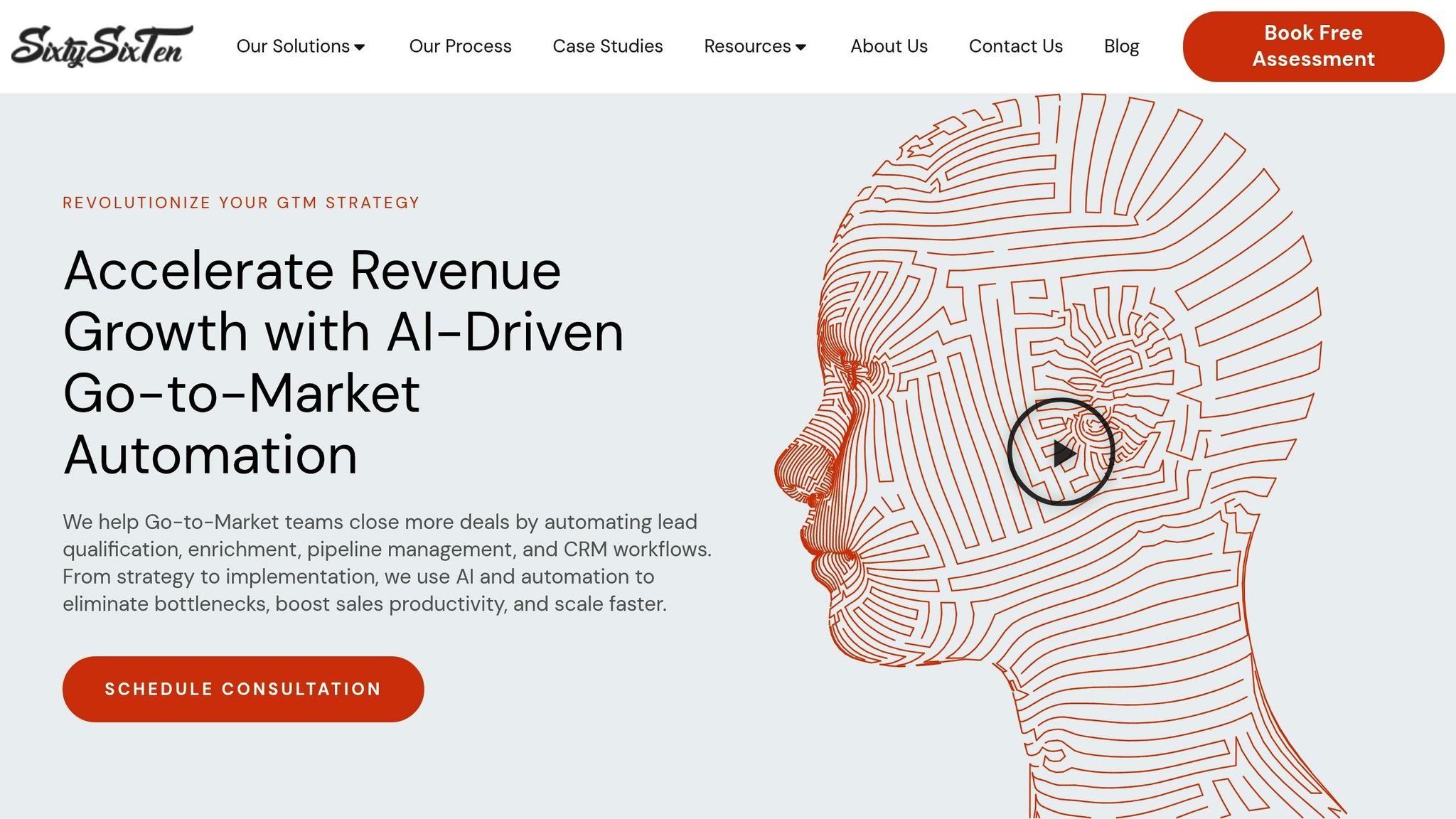Business Process Automation (BPA) helps businesses save time, reduce errors, and improve efficiency by automating repetitive tasks like data entry, lead management, and customer onboarding. It’s especially useful for scaling operations in industries like B2B SaaS, where managing high volumes of tasks manually becomes impractical.
Key Takeaways:
- What is BPA? Automation of rule-based tasks using technology to improve accuracy and free up employees for higher-value work.
- Why Use BPA? Reduces errors, speeds up processes, and supports business growth without increasing operational costs.
- Types of BPA:
- Task Automation: Handles single, repetitive tasks (e.g., email notifications).
- Workflow Automation: Automates multi-step processes (e.g., customer onboarding).
- Robotic Process Automation (RPA): Uses bots to manage tasks across systems.
- Intelligent Automation: Adds AI for decision-making (e.g., lead scoring).
- Hyperautomation: Combines RPA, AI, and machine learning for end-to-end automation.
- Implementation Steps:
- Identify repetitive, rule-based tasks.
- Map workflows and define goals.
- Select tools that integrate with your systems.
- Start small, test, and scale gradually.
- Popular Tools: n8n, Zapier, Make.com, and AI agents for tasks like CRM updates, lead qualification, and reporting.
BPA is not about replacing employees but enhancing their productivity by automating routine tasks. For B2B SaaS companies, it’s a critical strategy to handle growth efficiently without compromising customer experience or operational quality.
What is Business Process Automation? Pros, Cons, Myths & Tips
Types and Components of Business Process Automation
Grasping the different types of automation is crucial for businesses aiming to choose the best approach for their needs. Each type serves a distinct purpose and is tailored to specific scenarios, especially when scaling go-to-market operations.
Types of Business Process Automation
Task automation focuses on individual, repetitive activities within a broader process. Think of tasks like sending welcome emails or automatically updating customer records. This type is ideal for straightforward, rule-based actions that don’t require much decision-making. For instance, sales teams often rely on task automation to log calls in their CRM or set up follow-up reminders.
Workflow automation takes things a step further by linking multiple tasks into a cohesive process. Instead of automating a single step, it streamlines an entire sequence of actions. Picture this: when a lead downloads a whitepaper, workflow automation can add them to the CRM, assign a sales rep, send follow-up emails, and create a call task. This type is particularly useful for B2B SaaS companies navigating complex sales cycles with multiple touchpoints.
Robotic Process Automation (RPA) uses software bots to replicate human interactions with digital systems. These bots can log into applications, copy and paste data, complete forms, and handle other routine tasks. RPA shines in scenarios involving multiple systems that don’t integrate easily. For example, finance teams often use RPA to extract data from invoices and input it into accounting software.
Intelligent automation blends traditional automation with artificial intelligence, making it capable of handling more complex scenarios. It’s useful for tasks like analyzing support tickets to route them correctly or scoring leads based on their behavior. This type introduces a layer of decision-making and pattern recognition.
Hyperautomation goes all-in by combining technologies like RPA, AI, machine learning, and process mining to automate processes end-to-end. It looks at the entire business ecosystem, identifying opportunities to connect and streamline workflows across departments.
Core Components of BPA
Once you understand the types of automation, the next step is to break down the essential components that make these systems work effectively.
At the heart of any automation system are automated workflows. These define how tasks move from one step to the next, functioning like digital assembly lines. Modern workflow engines can handle complex branching logic, ensuring tasks follow the right path based on specific conditions or data.
Integration capabilities act as the connective tissue, linking different software applications to ensure seamless data sharing. Without proper integration, automation efforts can falter as information gets stuck in silos. Tools like APIs, webhooks, and middleware platforms enable systems like CRMs, marketing platforms, and accounting software to communicate effectively.
Data processing and transformation components ensure that data flows smoothly between systems, even when formats or structures differ. This might involve standardizing address formats, converting dates, or merging data from multiple sources into a unified record. Consistent, clean data is the backbone of reliable automation.
AI-driven decision-making adds intelligence by analyzing patterns and making decisions based on predefined criteria or learned behaviors. These systems can prioritize leads, suggest next steps, or flag anomalies that need human review. While AI handles routine decisions, it leaves more complex situations to humans.
Real-time monitoring and analytics provide a window into how automated processes are performing. Metrics like processing times, error rates, and completion rates help teams spot bottlenecks or areas for improvement. Effective monitoring systems also include alerts to notify teams of issues like process failures or unexpected performance drops.
User interfaces and control panels make automation accessible to non-technical team members. These tools allow users to trigger processes, track progress, and make adjustments without needing programming skills. The best platforms offer intuitive interfaces that empower business users to manage automation confidently.
Comparison of BPA Types
| Automation Type | Best Use Cases | Complexity | Timeframe | Ideal for B2B SaaS |
|---|---|---|---|---|
| Task Automation | Single, repetitive tasks like email notifications or data entry | Low | Days to weeks | Lead capture, CRM updates, basic email workflows |
| Workflow Automation | Multi-step processes such as customer onboarding or approval workflows | Medium | Weeks to months | Sales pipelines, customer success, marketing campaigns |
| RPA | High-volume data handling across multiple systems | Medium-High | Months | Invoice processing, data migration, reporting |
| Intelligent Automation | Decision-making processes like lead scoring or support ticket routing | High | Months to quarters | Predictive scoring, customer support, churn analysis |
| Hyperautomation | Enterprise-wide automation across departments | Very High | Quarters to years | Full go-to-market automation, lifecycle management |
The choice of automation often depends on a company’s stage in its automation journey. B2B SaaS companies typically begin with task and workflow automation to tackle immediate challenges in sales and marketing. As they grow more comfortable, they often transition to advanced methods like intelligent automation or hyperautomation for handling complex, cross-departmental processes.
Each type builds upon the last, creating a layered approach that can reshape business operations. The key is to start with clearly defined, measurable processes and expand gradually as teams grow more familiar with automated workflows.
How to Implement Business Process Automation
Implementing business process automation (BPA) successfully requires a clear, step-by-step approach. By starting with simpler, high-impact processes, businesses can lay the groundwork for more advanced automation in the future. For B2B SaaS companies, this strategy can lead to more efficient and scalable operations.
Assessing and Prioritizing Processes for Automation
The first step is to map out your current workflows to identify areas ripe for automation. Pay attention to processes that are time-consuming, repetitive, and follow specific rules. These are often the easiest to automate and can deliver quick results.
Tasks that occur frequently and involve predictable, rule-based decisions are excellent candidates. For instance, processes like lead qualification, customer onboarding, invoice processing, and support ticket routing often benefit greatly from automation. These workflows typically involve high volume and clear decision-making criteria, such as lead scores or customer segments, making them easier to program into automated systems.
Another area to consider is manual tasks prone to errors, such as data entry, calculations, or transferring information between systems. Automating these not only saves time but also improves accuracy and consistency.
When deciding which processes to automate first, think about how it affects the customer experience. Automating tasks like order confirmations, onboarding emails, or support responses can enhance customer satisfaction while lightening your team’s workload.
To prioritize, create a simple scoring system. Rate potential automation projects based on factors like time savings, ease of implementation, error reduction, and overall importance to your business. This helps focus efforts on processes that offer the biggest impact with minimal risk.
Don’t overlook cross-departmental workflows. Processes that involve sales, marketing, and customer success often include manual handoffs and communication gaps. Automating these can streamline operations and eliminate bottlenecks.
Designing and Deploying Automation Solutions
Once you’ve identified the processes to automate, the next step is to design the solutions. Start by mapping out every step of the workflow, including decision points and data requirements. This process helps uncover bottlenecks, redundancies, and areas where automation can make a difference.
It’s important to account for exceptions, not just the ideal or "happy path." Many automation projects fail because they don’t consider edge cases. Include these scenarios in your design to ensure the solution works smoothly in real-world conditions.
Define clear metrics to measure success. These could include processing time, error rates, or customer satisfaction scores. These benchmarks will help you assess the impact of automation and identify areas for improvement.
When selecting tools, consider your existing technology stack, team capabilities, and specific needs. Some processes may only require basic workflow automation tools, while others might need more advanced platforms with AI capabilities. Look for tools that integrate well with your systems, are easy to use, and fit within your budget.
Start small with pilot testing. Choose a specific department or a subset of the process for initial deployment. This allows you to identify issues, refine workflows, and build confidence before rolling it out across the organization.
Data migration and system integration are often the most challenging parts of deploying automation. Ensure data is clean and consistent before going live to avoid complications.
Finally, train your team and manage the transition effectively. Provide clear documentation, training sessions, and ongoing support to help employees adapt to the new workflows. Roll out the automation in phases, starting with core functionalities and gradually adding advanced features based on user feedback.
Governance and Continuous Improvement
Once your automation solution is live, maintaining its effectiveness requires ongoing governance. Assign process owners to monitor performance, address exceptions, and oversee improvements.
Regularly review both quantitative metrics and qualitative feedback. Monthly or quarterly reviews can help you spot trends, identify bottlenecks, and find opportunities for optimization. Metrics like processing volume, error rates, and user satisfaction should guide your evaluations.
Establish clear procedures for handling exceptions. Even the best automation systems will encounter scenarios they can’t handle. Define protocols for escalating these cases, resolving them, and updating automation rules to prevent future issues.
As automation systems grow more complex, version control and change management become critical. Document all changes to workflows, settings, and rules. This ensures consistency and simplifies troubleshooting.
Pay close attention to security and compliance, especially for processes involving sensitive data. Regular audits should verify that your systems meet regulatory requirements and maintain proper access controls.
Plan for scalability from the beginning. As your business grows or requirements change, your automation systems will need to adapt. Be ready to increase capacity, optimize performance, and add features as needed.
Collecting user feedback is another vital part of continuous improvement. Regular surveys, feedback sessions, and usage analytics can reveal pain points and highlight new opportunities. Often, users will come up with creative ways to use automation that weren’t considered during the initial design.
Finally, measure and report the return on investment (ROI) of your automation efforts. Track cost savings, productivity gains, and quality improvements over time. This data will help secure stakeholder support for future automation projects and guide your next steps.
Implementing BPA takes time and effort, but starting with smaller projects can build momentum and confidence. As your team gains experience, you’ll be ready to tackle more complex workflows and achieve even greater efficiency.
sbb-itb-647c22e
Tools and Technologies for Business Process Automation
Choosing the right tools can make or break your automation efforts. While many businesses start with basic workflow tools, B2B SaaS companies often turn to specialized platforms to tackle Go-to-Market (GTM) challenges. The trick is finding solutions that automate tasks while seamlessly integrating with your existing tech stack. Let’s dive into some standout options, starting with SixtySixTen’s tailored approach.
SixtySixTen and Engineering-Driven GTM Automation

SixtySixTen zeroes in on post-Product-Market Fit B2B SaaS companies, offering highly customized solutions. Their engineering-driven approach combines technical expertise with consulting to create bespoke GTM automation systems. By deeply embedding themselves in client operations, they identify opportunities to streamline workflows and improve efficiency, delivering measurable outcomes for over 100 companies worldwide.
"We help Go-to-Market teams close more deals by automating lead qualification, enrichment, pipeline management, and CRM workflows. From strategy to implementation, we use AI and automation to eliminate bottlenecks, boost sales productivity, and scale faster."
– SixtySixTen
Their solutions address critical GTM processes such as lead qualification, enrichment, pipeline management, CRM workflows, outbound prospecting, deal tracking, and conversion optimization. Using AI, their platform enables real-time lead scoring, enrichment, and segmentation, while speeding up follow-ups, demo scheduling, and pipeline handoffs.
SixtySixTen’s clients have seen impressive results, including a 30% revenue increase and a 2.5x boost in efficiency. Their advanced GTM analytics tools deliver even more striking metrics: an average ROI of 237%, 85% time savings on reporting, 93% improved data accuracy, and an average revenue impact of $2.4 million. These figures highlight how a focused approach can drive tangible improvements in revenue and operational efficiency.
One standout case involved a B2B SaaS company grappling with disconnected data across six tools and unreliable pipeline forecasting. By partnering with SixtySixTen, the company implemented automated GTM analytics, complete with custom dashboards and AI-driven insights. The results? An 85% reduction in reporting time, a 32% improvement in forecast accuracy, and the discovery of $1.2 million in pipeline opportunities.
SixtySixTen’s approach often involves combining tools like Clay, n8n, and custom AI agents with a client’s CRM and sales platforms. When pre-built tools fall short, they develop custom-coded solutions tailored to specific business needs.
Beyond SixtySixTen, there are numerous BPA tools available to enhance automation strategies.
Overview of Popular BPA Tools
The automation market is packed with platforms designed to meet a variety of needs. Here’s a look at some of the most widely used options:
- n8n: This open-source platform gives businesses full control over data and processes. Its node-based visual interface simplifies complex integrations, and its self-hosted option appeals to those with stringent data security requirements. With support for over 200 integrations and the ability to execute custom code, it’s ideal for businesses needing flexibility.
- Zapier: Known for its ease of use, Zapier connects over 5,000 apps and is perfect for automating straightforward tasks like lead capture, email notifications, or basic CRM updates. It’s a great starting point for teams new to automation.
- Make.com (formerly Integromat): This platform strikes a balance between simplicity and power. Its visual scenario builder handles complex workflows with conditional logic, data transformation, and error handling. It’s particularly effective at managing large data volumes and intricate business logic, making it a strong choice for mid-market companies.
- AI Agents: These systems represent the next generation of automation tools. They go beyond simple workflows, using data analysis to make decisions and adapt to changing conditions. For example, AI agents can dynamically score leads based on engagement patterns, trigger personalized outreach, or analyze sales conversations to suggest next steps.
The best tool for your business depends on factors like technical expertise, integration needs, and the complexity of your workflows. Many companies find success by combining multiple tools to create a comprehensive automation strategy.
Integration Strategies
The success of any automation initiative hinges on seamless integration between tools and existing systems.
- CRM Integration: This is the backbone of most GTM automation strategies. Automation tools need real-time access to customer data, deal stages, and interaction history to function effectively. Native CRM integrations generally offer better performance and reliability than third-party connectors.
- ERP Integration: As automation extends into operations and finance, ERP integration becomes critical. Automated workflows require access to inventory levels, pricing, and financial records to make informed decisions about approvals, product availability, and credit limits. These integrations often demand advanced technical skills due to the complexity of ERP systems.
- Data Visualization Platforms: Tools like Google Looker and PowerBI are essential for turning automation insights into actionable strategies. By integrating these platforms, businesses can automatically populate dashboards with real-time metrics, pipeline health indicators, and ROI calculations, enabling continuous optimization.
To ensure smooth integration, it’s essential to establish clear data governance from the outset. Define which systems will serve as the source of truth, set validation rules, and implement automated error handling. This ensures all tools in your automation ecosystem work harmoniously.
- API Management: As your automation stack grows, managing APIs becomes increasingly important. Documenting integration points, monitoring usage limits, and maintaining robust security protocols are critical. Regular updates and troubleshooting should also be part of your strategy.
A hub-and-spoke integration model can simplify the process. In this setup, a central platform manages data flow between systems, reducing the complexity of point-to-point integrations. Platforms like n8n excel in this role, acting as the central hub for your automation ecosystem. This approach makes it easier to add new tools or modify workflows without disrupting existing systems.
Best Practices for Business Process Automation
Overcoming Common Challenges
It’s natural for employees to feel uneasy about changes, especially when automation is involved. Concerns about job security, fear of the unknown, or even past negative experiences can create resistance. To ease these worries, it’s essential to acknowledge them upfront and address them thoughtfully. This approach not only helps build trust but also ensures smoother adoption of automated processes.
Conclusion
Business process automation has become a key strategy for B2B SaaS companies aiming to scale efficiently. By adopting automation, companies can manage growth without a corresponding increase in operational costs or manual effort. To make it work, there are three guiding principles to keep in mind.
First, carefully evaluate your processes and focus on automating those that offer the greatest impact. Second, select the right tools for your needs – whether that’s leveraging no-code platforms like n8n and Zapier for quick wins or investing in custom-coded solutions for more complex tasks. Finally, support your team throughout the transition – automation thrives when employees understand its purpose and feel equipped to embrace it.
For B2B SaaS companies, automation becomes even more critical as you scale beyond product-market fit. Growth brings challenges like higher lead volumes, more intricate sales processes, and expanding customer bases. Without efficient systems, these demands can overwhelm your operations. Automation provides the infrastructure to scale smoothly, enabling your GTM teams to handle growth – from hundreds to thousands of leads – without breaking down.
The best automation strategies combine thoughtful planning with technical expertise. It’s not just about deciding what to automate but designing systems that grow alongside your business. Success requires a deep understanding of the available tools and the unique challenges faced by B2B SaaS GTM teams. When done right, this approach delivers measurable results.
With the right tools and a people-first mindset, you can take your processes to the next level. SixtySixTen’s engineering-driven GTM automation solutions are tailored to your business. Whether it’s streamlining CRM workflows or implementing AI-powered prospecting systems, we specialize in eliminating manual tasks that slow you down. This lets your team focus on what really matters – building relationships and closing deals.
The real question isn’t whether to automate – it’s how quickly you can start and which processes will create the most impact. Your competitors are already automating. Don’t wait – take action now to stay ahead.
FAQs
What’s the best way for a business to identify processes that should be automated?
When deciding which processes to automate, start by identifying tasks that are repetitive, time-intensive, and susceptible to human error. Examples include data entry, invoice handling, or approval processes. These types of tasks usually involve straightforward, rule-based actions, making them ideal for automation.
It’s also important to assess processes based on factors like how often they occur, their complexity, and how much they influence overall productivity. Focus on workflows that align with your business objectives, save a notable amount of time, and enhance accuracy. By zeroing in on these areas, you can streamline operations and make the most of automation.
What challenges might arise when implementing business process automation, and how can they be resolved?
Implementing business process automation often comes with its fair share of hurdles. These might include untangling complex workflows, dealing with outdated legacy systems, overcoming resistance to change, ensuring user adoption, addressing scalability issues, managing security risks, and handling the high initial costs.
To navigate these challenges, start by conducting a thorough audit of your current workflows. This helps pinpoint inefficiencies and highlights areas ripe for improvement. Opt for automation tools that are intuitive and align with your business needs. Providing comprehensive training for your team can also make a big difference in gaining their support and confidence.
Additionally, plan ahead for scalability to ensure your automation solution can evolve alongside your business. Don’t overlook security – protecting sensitive data should always be a top priority. By approaching automation with careful planning and a clear strategy, you can tackle these challenges head-on and pave the way for a smoother transition.
How does automating business processes affect employee roles and productivity?
Business process automation boosts productivity by taking over repetitive, manual tasks, freeing employees to tackle more strategic and creative projects. This not only improves efficiency but also makes work more satisfying by cutting out the monotony.
It also simplifies workflows, reduces mistakes, and speeds up service delivery, enhancing overall performance across teams. With automation handling routine tasks, employees can focus on work that demands critical thinking and innovation, leading to a more dynamic and fulfilling workplace.



